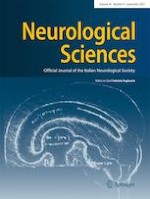Erschienen in:

17.06.2022 | Original Article
Comparative safety of high-efficacy disease-modifying therapies in relapsing–remitting multiple sclerosis: a systematic review and network meta-analysis
verfasst von:
Katarzyna Śladowska, Paweł Kawalec, Przemysław Holko, Oktawia Osiecka
Erschienen in:
Neurological Sciences
|
Ausgabe 9/2022
Einloggen, um Zugang zu erhalten
Abstract
Objective
This study aimed to compare the safety profile of high-efficacy disease-modifying therapies (DMTs) natalizumab, fingolimod, alemtuzumab, cladribine, ocrelizumab, ofatumumab, ozanimod, as well as a potentially high-efficacy DMT, ponesimod, in adult patients with relapsing–remitting multiple sclerosis (RRMS).
Methods
A systematic review with frequentist network meta-analysis (NMA) was performed according to the Preferred Reporting Items for Systematic Reviews and Meta-analyses (PRISMA) guidelines. We included randomized controlled trials (RCTs) with at least 48-week follow-up investigating the use of natalizumab, fingolimod, alemtuzumab, cladribine, ocrelizumab, ofatumumab, ozanimod, and ponesimod, as well as other DMTs, in adult patients with RRMS. Eligible studies were identified by two reviewers in MEDLINE (via PubMed), EMBASE, and Cochrane Library. The Cochrane Collaboration tool to assess the risk of bias for RCTs was used.
Results
A total of 33 RCTs were included in the systematic review and NMA. A higher rate of adverse events (AEs) was revealed for alemtuzumab versus all other high-efficacy DMTs; for alemtuzumab (average probability of an event: 98.2%) versus placebo (86.2%); for cladribine (3.5 mg; 90.5%) versus ozanimod (1 mg; 84.2%) and placebo; as well as for ocrelizumab (95.5%) versus ozanimod, ofatumumab (88.9%), fingolimod (87.4%), natalizumab (82.8%), and placebo. No significant differences were found between drugs in terms of serious AEs except for cladribine (3.5 mg, 17.3%) versus ocrelizumab (10.3%) and ofatumumab (16.6%) versus ocrelizumab. Significant differences in AEs leading to the discontinuation of study drug were found only for ponesimod (10.1%) versus alemtuzumab (12 mg, 3.0%) and placebo (4.2%). No differences were found in terms of upper respiratory tract infections, nasopharyngitis, fatigue, and nausea between individual high-efficacy DMTs as well as between DMTs and placebo. The results of the NMA indicated a higher risk of infections for alemtuzumab (12 mg) versus ocrelizumab, for cladribine (3.5 mg) versus ofatumumab and placebo, and for ofatumumab versus placebo. For serious infections and urinary tract infections, a significant increase was found only for alemtuzumab (12 mg) versus ocrelizumab, while no differences were found between the other DMTs or between DMTs and placebo. Headache was more common for alemtuzumab (12 mg) as compared with all the other high-efficacy DMTs and placebo, as well as for cladribine versus natalizumab and fingolimod versus natalizumab.
Conclusion
The commonly reported AEs are generally similar among high-efficacy DMTs. However, based on P scores for most analyzed endpoints, natalizumab and ocrelizumab were shown to be the safest DMTs. Considering the limitations of indirect comparisons, further research is needed to confirm our findings, preferably head-to-head RCTs and large observational studies.











